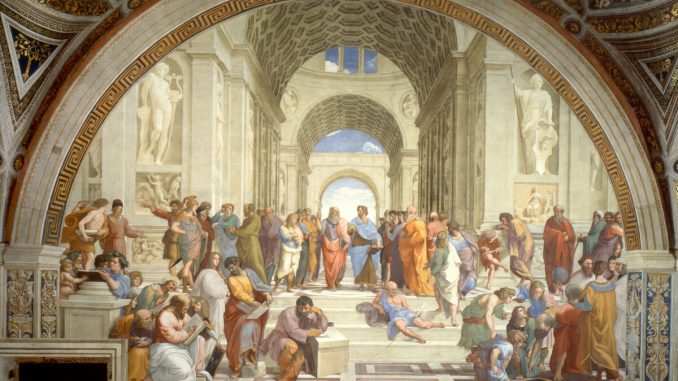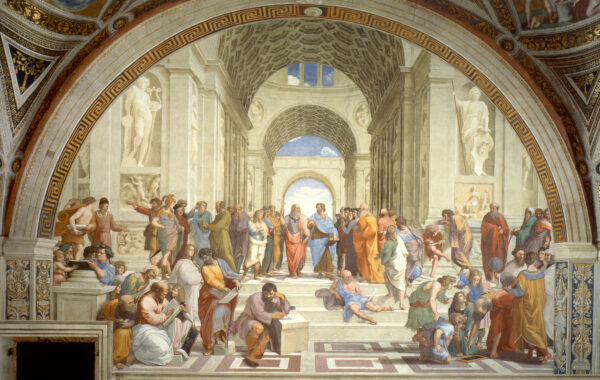
“The School of Athens” is one of the most important and fascinating frescos in Western art history. Pope Julius II commissioned the prolific young artist Raffaello Sanzio da Urbino to decorate his private chambers in the Vatican.
The first room that Raphael (1483–1520), as he is better known, tackled was the “Stanza Della Segnatura,” or “Room of the Signature,” so-called because it was where the Church’s most significant documents were signed, sealed, and set into enforceable doctrine. The room also served as the Pope’s library and as the meeting place for The Supreme Tribunal of the Apostolic Signatura—the most powerful judicial body of the Catholic Church.
Whatever colors and shapes, narratives and rhythms would ultimately adorn the four walls of this momentous chamber would oversee, if not potentially influence, some of the most consequential decisions affecting the lives (and afterlives) of all those who inhabited the sprawling Holy Roman Empire.
The stakes could not have been higher, and Raphael knew it. The huge fresco which measures over 16 feet high by 25 feet long was a formidable challenge for a young man still in his 20s. There was a tradition of decorating private libraries with portraits of great thinkers, but Renaissance-artist Raphael took the idea to a different stratosphere.
Fulfilling the Zeitgeist
The Renaissance was a manifestation of the renewal of the interest in Ancient Greek and Roman philosophy, art, religion, and culture. Raphael’s genius was to represent this in a painting.
His subject depicts the central debate in Western philosophy: The different premises between philosophers concerned with matters of the spiritual world and those concerned with the physical world.
Thus, Raphael’s iconography was sheer genius. It is a depiction of those thinkers who have shaped—and continue to shape—Western civilization. These are the minds that celebrate truth acquired through reason.
“School of Athens” was a visual manifestation of the zeitgeist.
Not only did Raphael beat competitors such as Michelangelo and Leonardo to win the commission, but Raphael’s work gained rapturous reviews.

‘The School of Athens’
There are 50 figures depicted, including Plato, Aristotle, Socrates, Pythagoras, in an imaginary architectural scenario. The two most prominent and central characters are the founding fathers of Western philosophy: Plato and his disciple Aristotle.
Plato points up because in his philosophy presents a spiritual premise: The changing world that we see around us is just a shadow of a higher, truer reality that is eternal and unchanging and includes things like goodness and beauty. For Plato, this otherworldly reality is the ultimate reality, and the seat of all truth, beauty, justice, and wisdom.
Plato holds his book called the “Timaeus,” suggesting his cosmological theories, depicting the divide between his and Aristotle’s philosophies.
By his palm facing down, Aristotle is suggesting the basis of his practical ethics, because in his philosophy, the only reality is the one that we can see and experience by sight and touch—exactly the reality dismissed by Plato.
Aristotle’s “Ethics,” the book that he holds, emphasized elements of the human world such as justice, friendship, and government.
Each figure to Plato’s right represents Plato’s theories on philosophy, while on Aristotle’s left, they represent Aristotle’s.
The characters in “The School of Athens” celebrate classical thought, but homage is also paid to the liberal arts, symbolized by the two statues of Apollo, God of light, archery, and music, and Athena, goddess of wisdom in the Roman form of Minerva.
The setting in which all are gathered is Roman. The ceiling is inspired by the Basilica of Maxentius and Constantine, the largest building in the ancient Roman Forum. The architectural structures seem to symbolize and underline the depth and monumental import of what the protagonists believe.
Raphael’s Genius
The painting shows Raphael’s intellectual use of linear perspective, with a central vanishing point at Socrates’s left hand. Raphael also mastered the signature techniques of High Renaissance art such as “sfumato” (softening the transitions between colors), precise anatomical correctness, and authentic emotionality and expression.
His individual style had a singular grandeur. Still it was filled with humanism and noted for its clarity, rich color, and effortless composition.
Michelangelo and Leonardo, who, together with Raphael, comprise the genius triumvirate of the Renaissance, appear in the painting. Leonardo is disguised as Plato, Michelangelo is Heraclitus, and Raphael appears at the extreme right, in a dark hat.
Renaissance chronicler of art Vasari acknowledged that Raphael gave the elder artist Michelangelo a run for his money:
“Raphael of Urbino had risen into great credit as a painter, and his friends and adherents maintained that his works were more strictly in accordance with the rules of art than Michelangelo, affirming that they were graceful in coloring, of beautiful invention, admirable in expression, and of characteristic design; while those of Michelangelo, it was averred, had none of those qualities with the exception of the design. For these reasons, Raphael was judged, by those who thus opined, to be fully equal, if not superior, to Michelangelo in painting generally, and… decidedly superior to him regarding coloring in particular.
It is said that the light that burns twice as bright burns half as long. So, it was with Raphael. His brilliant career in Rome represents the most fulminating jewel in the crown of Western civilization that is the Renaissance. He died at only 37 and was buried in the Pantheon.
Jani Allan is a journalist, columnist, writer, and broadcaster.





Be the first to comment